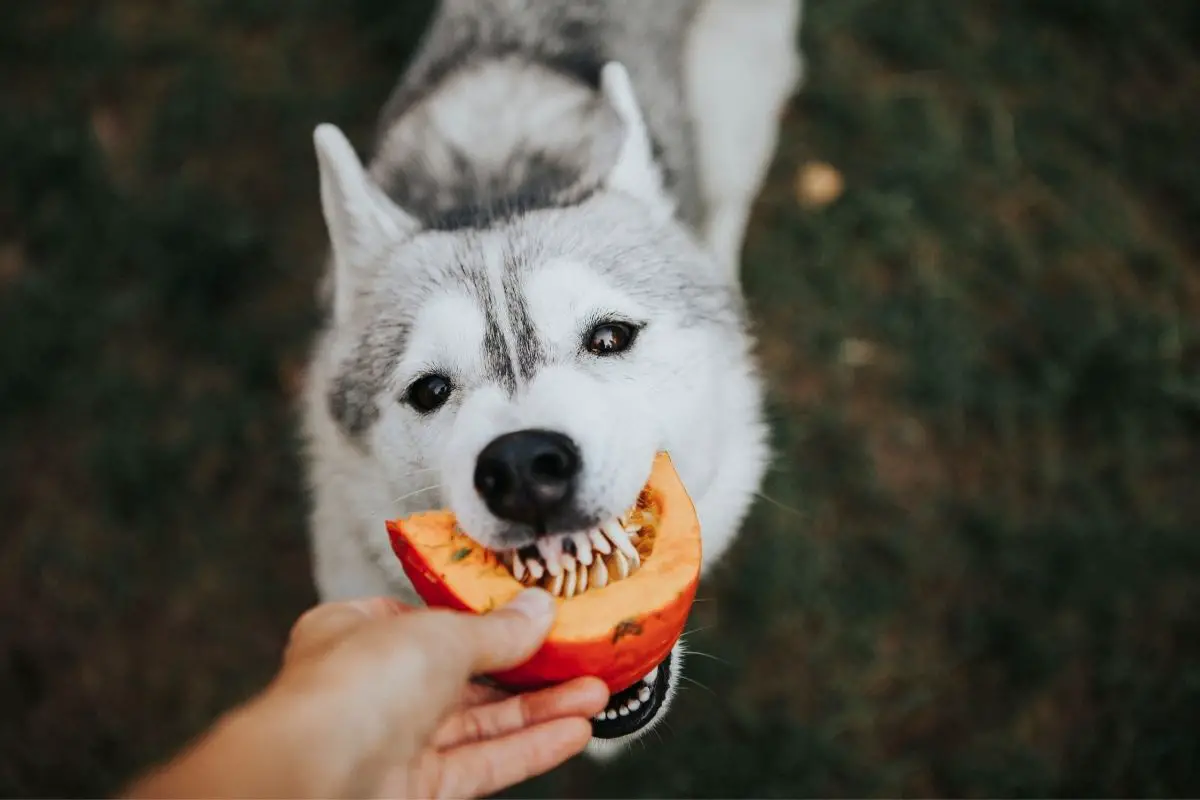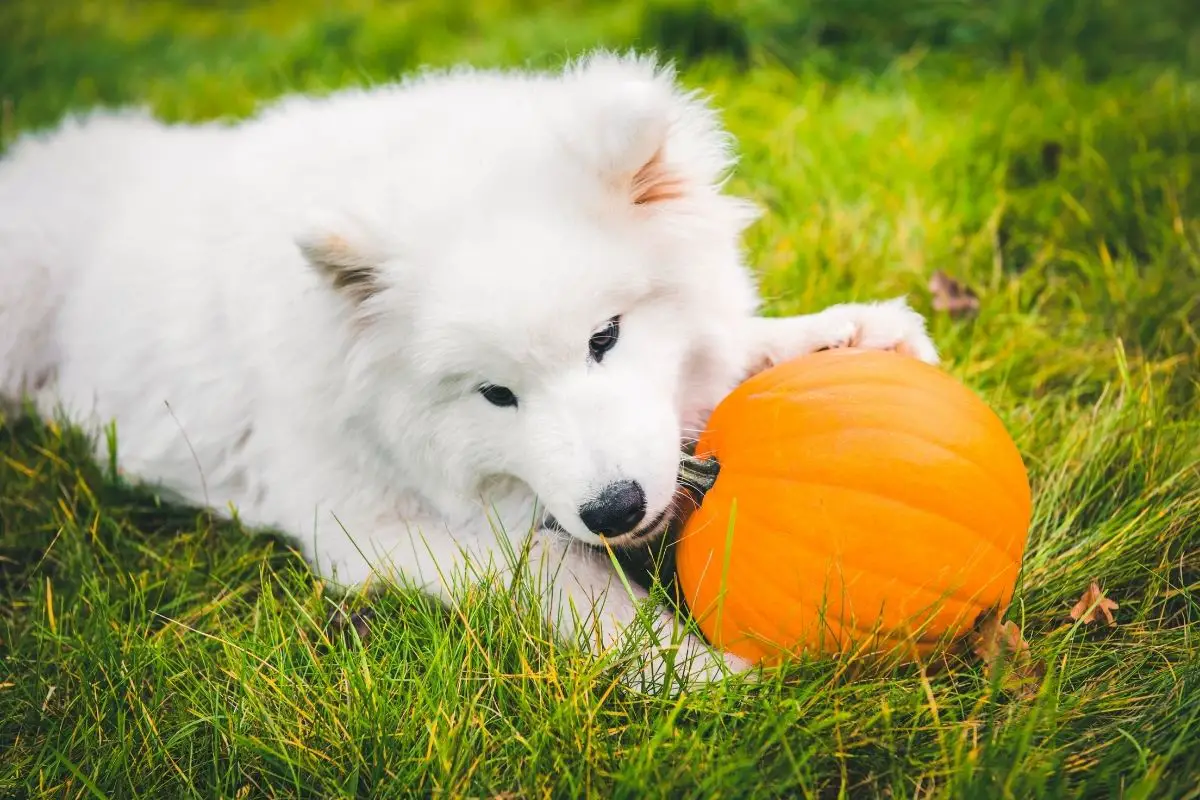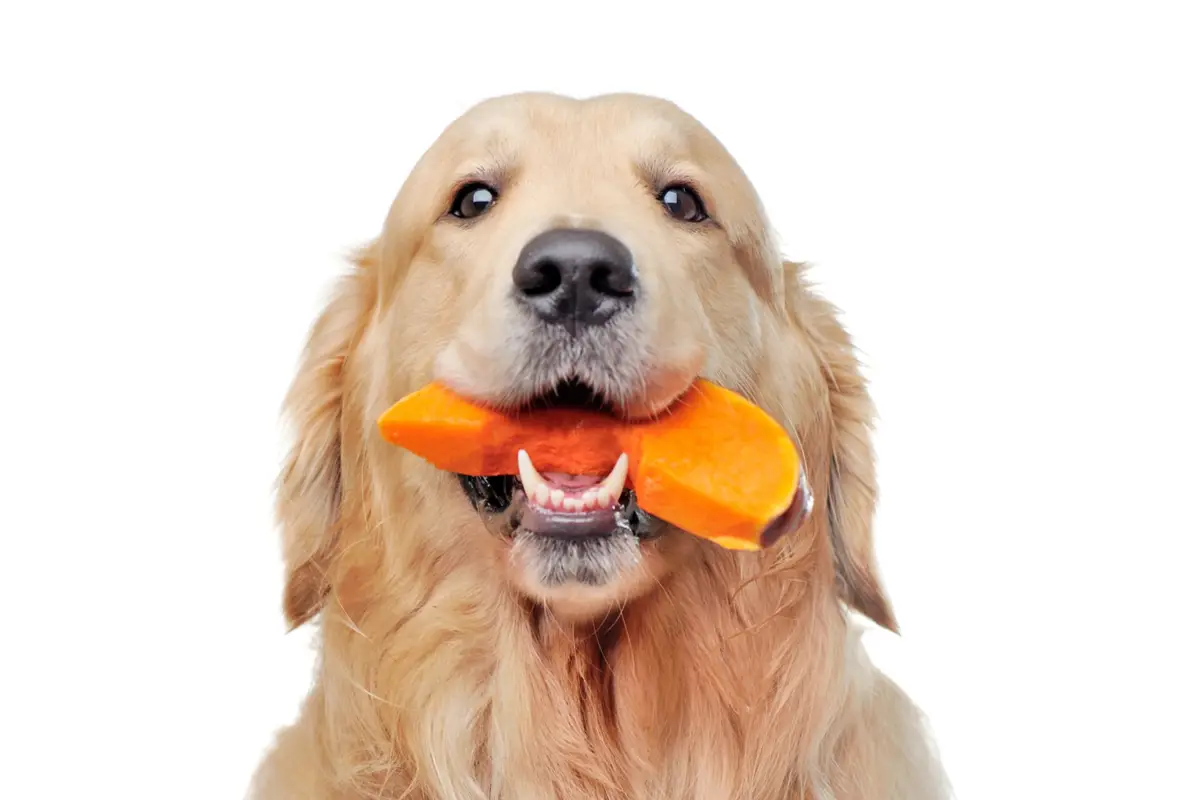It sounds a bit questionable, but pumpkin is a natural treatment for both diarrhea and constipation in dogs.
It’s normal for dogs to experience diarrhea sometimes, but constipation is not as common.
Usually, it will go away on its own if it is a mild case but sometimes, an underlying health condition is the culprit which is when more than some pumpkin will be needed to put things right.
Contents
How Does Pumpkin Help Constipation In Dogs?
Pumpkin contains a lot of fiber and water which adds bulk to the stool and softens it, much like a natural laxative.
Fiber is also very beneficial for the dog’s gut health as it behaves in the same way as a prebiotic which encourages the growth of healthy bacteria in the intestines.
There are other health benefits that come with feeding your dog pumpkin.
There are lots of nutrients in pumpkin that your dog needs in order to be healthy such as vitamin E, A, and C that help the brain function, the immune system, and the overall health of the skin and eyes.
Copper, manganese, potassium, and iron are also found in pumpkins, these help the cells within the body function properly.
There is carotenoid zeaxanthin as well that protects the dog’s eyes from light damage.
How To Give Pumpkin To Your Dog
These are the best ways to prepare the pumpkin before you give it to your dog.
Freshly Baked Pumpkin
A nice, fresh pumpkin will ensure that your dog gets the best of the best vitamins and minerals.
To prepare the pumpkin, remove the seeds first and put it in the oven to bake until it is soft.
Canned Pumpkin
Canned pumpkin that is plain is good to give to your dog because you don’t need to cook it, making it a quick and easy solution.
Make sure that the canned pumpkin you get does not have any additives and serve it to your dog straight from the can.
Crunchy Roasted Pumpkin Seeds
If your dog does not seem to like the other ways that the pumpkin is served, you can try giving them the seeds as a nice crunchy treat.
The seeds should be cleaned and roasted for about an hour at 350 degrees before being left to cool and grounded up to put into the dog’s food.
You can also feed them whole to the dog if you know that they are not at risk of getting stuck in their throat or digestive system, so if your dog is small it is best to grind them up.
Pumpkin Purée
By turning the pumpkin into a paste, it becomes much more versatile as you can use it as an addition to their food, a treat, or as a filling for kongs.
To make the pumpkin purée, you will need to get a whole pumpkin, scoop out the seeds and slice it into chunks. Put the chunks into boiling water and let them simmer for about 20 to 30 minutes until they are soft.
Then, drain and mash the pumpkin until it resembles a smooth paste. It will stay fresh for up to four days if you store it in the fridge and can last up to six months in the freezer.
How Much Pumpkin Should I Give My Dog?

A general rule for how much pumpkin to give your dog is for every 10 pounds of body weight on your dog, you can give them one teaspoon of pumpkin.
If your dog has diabetes, you must talk to your vet before you give them pumpkin.
When you add pumpkin to their diet, make sure that they have access to plenty of water to prevent them from suffering from dehydration.
Within 24 hours, you should start to see results but if your dog is still constipated, you should take them to the vet as it is evidently more serious.
Also, if your dog does poo within 24 hours, do not be alarmed if their poo is orange as this is due to the compound called carotene which also makes the pumpkin orange.
Potential Harmful Effects Of Pumpkin
Giving your dog too much pumpkin can lead to a lot of issues.
Even though fiber is great in the right amounts, having too much of it can lead to nutrient deficiencies because the dog will not be able to absorb as much protein as well as other nutrients.
Pumpkin is quite high in calories and if it takes up more than 10% of your dog’s diet is too much and over time can lead to them being overweight or even obese.
Pumpkin in cans can have a lot of sodium, so you must check the label before you buy. Giving your dog too much sodium will put them at risk of developing heart and kidney disease.
Causes Of Constipation In Dogs
Pumpkin can treat a lot of dogs with constipation, but it’s best to understand why it happened in the first place, especially if the pumpkin is not offering any amount of relief.
Swallowing The Wrong Things
Ingesting objects that they shouldn’t have can block their digestive tract and lead to constipation.
Some dogs have a condition called pica which gives them the urge to eat objects even if they are not food.
Some dogs are also known to eat hair, grass, and bones especially if they like to rummage around in the wilderness. Almost every dog loves bones, but they struggle with digesting them.
Hair can be swallowed by dogs who are very hairy and when grooming, accidentally ingests some hair which over time can cause a blockage.
If your dog is prone to this you should groom them regularly so that the hair ends up on your brush instead of in their stomach.
It is quite common to see your dog eat grass from time to time, there are different reasons why they do this but most of the time it is to settle their stomach.
If you find that your dog eats grass a lot, you should take them to the vet as it could be a sign that they are suffering from something more serious.
Eating too much grass also tends to lead to constipation because it is difficult for them to digest.
Poor Diet
If your dog does not have enough fiber in its diet, it can lead to constipation because fiber is essential for adding water to the waste as it moves through the body.
If there is no fiber, the waste becomes hard and much more difficult to pass through without straining and pain. In severe cases, the build-up of waste can lead to a blockage.
Not Enough Exercise
Not giving your dog enough exercise will prevent the digestive tract from being stimulated properly.
This is why your dog is much more likely to poo when you are on a walk because when their body is active, their digestive tract is too.
Therefore, if your dog is not active enough, its intestines will be functioning more slowly and will make everything feel more sluggish overall.
Digestive Problems
A lack of healthy bacteria in the gut can lead to digestive problems but health conditions such as inflammatory bowel disease can have constipation as one of the symptoms.
Prostate And Anal Gland Problems
Constipation can also be caused by an enlarged prostate as well as anal glands that are full or swollen.
When the glands get blocked, they are not able to release any fluid which is used to coat the waste as it comes out.
Signs Of Constipation In Dogs

As well as not being as regular, there are other signs that your dog is struggling with constipation.
Every dog will have different bowel movements, with some going once a day and others going up to four times a day.
If 48 to 72 hours have passed and your dog still hasn’t had a bowel movement, it means that they are constipated.
As well as frequency, you should look at the consistency of the poo. If it appears hard and smaller than normal, then it is likely due to constipation.
Do they look like they are straining to get rid of it? If so, they are likely straining because it is too hard, and they are having trouble with moving it through their bowels.
Whining and showing other signs of discomfort or pain when pooing are other indicators.
Other Natural Remedies For Constipation In Dogs
If pumpkin is doing the job of easing your dog’s constipation, you can try one of these natural remedies.
Coconut Oil
Coconut oil is very good for softening your dog’s stool and is very easy to mix in with their food.
You should only use a very small amount because too much coconut oil could throw your dog on the other end of the spectrum and give them diarrhea.
The same rule of how much pumpkin to give your dog is the same as how much coconut oil to give them which is one teaspoon for every 10 pounds that your dog weighs.
Olive Oil
Olive oil works similarly as coconut oil because it softens the stool and lubricates the digestive tract.
You only need to add a small amount to their food and the results should follow soon after.
You should not resort to using olive oil too often, instead, you should take your dog to the vet if they have reoccurring constipation.
Apple Cider Vinegar
A popular remedy for dog constipation is apple cider vinegar, just add a few drops to your dog’s water bowl. Adding too much will irritate your dog’s stomach instead of helping it.
Stimulate Their Digestive System
If your dog gets constipation only on occasion, you can try stimulating their digestive system to help things along.
Physical massages, more exercise, and changes to their diet will all help with stimulating their digestive system.
The physical massages around the stomach must be very gentle because your dog is probably already experiencing discomfort.
A simple belly rub should work in most cases. All you have to do is get your dog to lie down on their side and with light pressure, rub their belly with your palm in a clockwise direction for about five minutes.
Summary
As well as helping with constipation, giving your dog some pumpkin can benefit their health in a lot of ways.
It can go wrong though if you do not prepare the pumpkin the right way or give them too much of it.
You should give your dog one teaspoon of pumpkin for every 10 pounds of body weight.
By giving them the proper amount of pumpkin, you will avoid the potentially harmful effects such as becoming deficient in nutrients because the pumpkin alters their ability to absorb them, too many calories which leads to being overweight or obese, and heart and kidney disease due to high sodium found in some canned pumpkin.



